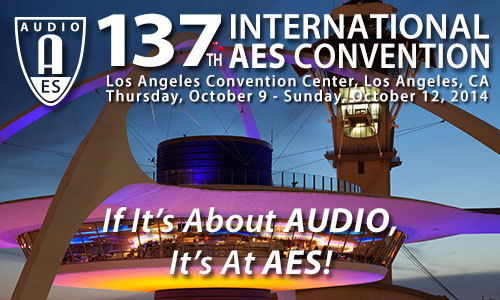AES Los Angeles 2014
Paper Session P2
P2 - Education
Thursday, October 9, 9:00 am — 11:30 am (Room 309)
Chair:
Tim Ryan, Webster University - St. Louis, MO, USA
P2-1 Apprenticeship Skills in Audio Education: A Comparison of Classroom and Institutional Focus as Reported by Educators—Doug Bielmeier, Middle Tennessee State University - Murfreesboro, TN, USA
Recent research of audio industry employers indicated that their new hires lacked communication skills, which the employers deemed valuable for their new hire’s success. In this research audio engineering technology (AET) educators were surveyed about the communication skills focused on in their classrooms, focus of their departments/ institutions, and their internship programs. The quantitative data suggested that both educators and their institutions lacked a focus on apprenticeship skills. Also, fewer than half of the institutions required an internship. Further research must be conducted to understand what these educators reported and how it affects AET education as a whole.
Convention Paper 9101 (Purchase now)
P2-2 Partnering Approaches for Teaching Music Technology—Jeffrey Rodgers, University of Saint Francis - Fort Wayne, IN, USA; Purdue University
The use of collaborative learning techniques is rapidly becoming a popular method for teaching 21st century skills across the United States. The term “Partnering” has been used to refer to different types of collaborative learning; most recently being defined by Marc Prensky in his book, Teaching Digital Natives, Partnering for Real Learning. This paper addresses the need for more established methods for teaching music technology skills, concepts, and theories that utilize a collaborative, partnering style of instruction. Specifically, these partnering methods are intended for students in high school and higher education.
Convention Paper 9102 (Purchase now)
P2-3 Pathways through Recording Analysis—William Moylan, University of Massachusetts - Lowell - Lowell, MA, USA
If you are in the audio industry, you analyze recordings. What do you listen for? What do you hear? Why are you listening? There are many relevant answers to these questions depending on one’s role in the industry or purpose for listening. This paper will explore the process of recording analysis and the idea of “pathways” through the many elements, dimensions, and functions that it might address; pathways that can be modified to suit the material and purpose for the analysis. Music recording will then be used as an example to bring a focus to the process. “Recording analysis” will then be the study of sound qualities of recordings and the interrelationships of those qualities and the music’s materials and structure and its text.
Convention Paper 9103 (Purchase now)
P2-4 Case Study: University Recording Arts Program Seeks to Educate, Engage, and Recruit High School Students—Leslie Gaston-Bird, University of Colorado Denver - Denver, CO, USA; Lorne Bregitzer, University of Colorado Denver - Denver, CO, USA; Lynnae Rome, University of Colorado Denver - Denver, CO, USA
A team of researchers from the University of Colorado Denver Recording Arts program visited the Denver School of the Arts high school in an effort to discover (1) whether students could detect an audible difference between music encoded as AAC and MP3 when comparing them to the original WAV file, (2) whether a trend in music career choices would appear based on gender, and (3) whether this visit could serve as an ongoing recruitment activity. The results presented here could be useful for other universities who want to engage in these activities. We will also consider the time, cost, and impact of a day-long visit.
Convention Paper 9104 (Purchase now)
P2-5 Musical Chairs: From Spectator to Stage—Mike Godwin, University of Western Ontario - London, ON, Canada; Leslie Linton, University of Western Ontario - London, Ontario, Canada
This presentation demonstrates an interdisciplinary and multidisciplinary project that involves the creation of an interactive computer application involving the fields of music education, music performance, acoustical engineering, and computer science. Typical music computer programs or “apps” usually involve creative strategies to explore various techniques for teaching the elements of music theory, history or composition and often use computer generated characters and music. This “app” is quite different in that it allows users to explore (tap, touch, pinch-to-zoom) actual performances through video; they can seamlessly “walk” through the orchestra, band or choir, and as they move around the audio changes according to where they are situated. Imagine “Google street view” with seamless video and audio instead of connected still photos and no sound.
Convention Paper 9105 (Purchase now)
